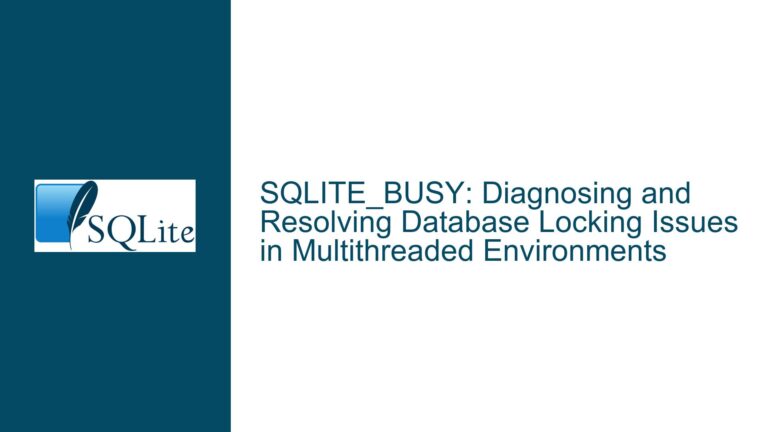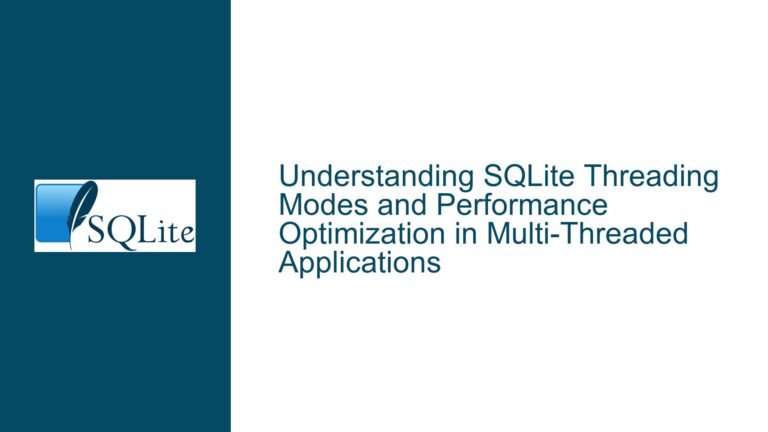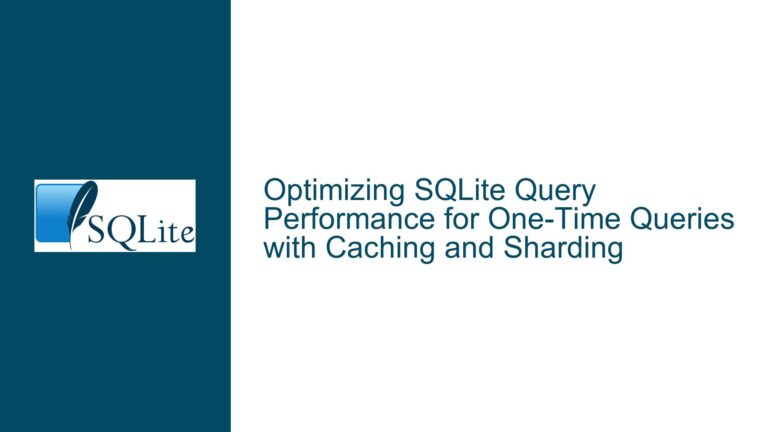Resolving “Database is Locked” Errors in SQLite with Concurrent Read/Write Operations
Understanding SQLite Locking Behavior and Concurrency Limitations
Issue Overview
SQLite’s concurrency model is fundamentally different from client-server databases due to its embedded nature. When multiple threads or processes attempt to interact with the same database simultaneously, SQLite employs a locking protocol to ensure data consistency. The "database is locked" OperationalError arises when a thread attempts to read from or write to the database while another thread holds an incompatible lock. This problem is particularly acute in multithreaded applications where long-running transactions, improper isolation levels, or misconfigured journal modes exacerbate contention.
The core issue revolves around SQLite’s locking states:
- UNLOCKED: No thread is accessing the database.
- SHARED: One or more threads are reading the database. Multiple SHARED locks can coexist.
- RESERVED: A thread intends to write to the database. Only one RESERVED lock is allowed.
- PENDING: A thread with a RESERVED lock is ready to commit changes and is waiting for existing SHARED locks to release. No new SHARED locks can be acquired.
- EXCLUSIVE: The thread is actively writing to the database. No other locks are permitted.
In the default rollback journal mode, a writer must escalate from RESERVED to EXCLUSIVE to commit changes. During this escalation, readers holding SHARED locks force the writer to wait. If the writer cannot acquire the EXCLUSIVE lock within a timeout period, it aborts, resulting in SQLITE_BUSY (manifested as "database is locked" in many language bindings). Conversely, readers attempting to acquire SHARED locks during a PENDING or EXCLUSIVE state will also fail.
The interplay between these states explains why long-running write transactions block readers and why read-heavy workloads can starve writers. For example, a thread performing a bulk insert (holding RESERVED) might inadvertently block new readers once it transitions to PENDING. Similarly, a read transaction that remains open for an extended period can prevent a writer from acquiring EXCLUSIVE access.
Diagnosing the Root Causes of Lock Contention
Possible Causes
Default Rollback Journal Mode Limitations:
In rollback journal mode (the default), SQLite uses a write-ahead logging mechanism that requires exclusive access during commit phases. Writers escalate locks from RESERVED to EXCLUSIVE, which blocks new readers once PENDING is acquired. This design prioritizes data integrity over concurrency, making it unsuitable for applications with frequent overlapping read/write operations.Long-Running Transactions:
Transactions that remain open for extended periods (e.g., iterating over a large dataset while holding a transaction) prolong lock retention. A write transaction in RESERVED state prevents other writers but allows readers until it escalates to PENDING. If the writer spends significant time in RESERVED (e.g., due to complex queries or application logic delays), the window for read contention increases.Insufficient Busy Timeout Configuration:
SQLite’ssqlite3_busy_timeout()function (or equivalent in ORMs like SQLAlchemy) determines how long a thread will retry acquiring a lock before returningSQLITE_BUSY. If unconfigured, the library aborts immediately upon encountering contention, leading to frequent "database is locked" errors.Cache Spillage and Premature Lock Escalation:
When a write transaction’s memory cache (configured viaPRAGMA cache_size) exceeds its limit, SQLite spills dirty pages to disk. This forces an early transition from RESERVED to PENDING, expanding the time window during which new readers are blocked. For example, a transaction modifying 10,000 rows with a smallcache_sizemight spill repeatedly, causing intermittent lock contention.Improper Use of Transaction Control Statements:
Ambiguous use ofBEGIN,BEGIN DEFERRED,BEGIN IMMEDIATE, orBEGIN EXCLUSIVEcan lead to suboptimal locking behavior.BEGIN DEFERRED(the default) acquires a SHARED lock initially, escalating to RESERVED when a write occurs. If two threads issueBEGIN DEFERREDand attempt writes simultaneously, one will fail to escalate to RESERVED.Connection Pooling and Thread Isolation:
ORMs like SQLAlchemy often employ connection pools. If connections are reused across threads without proper isolation, lingering transactions or locks from one thread can affect others. For instance, a connection returned to the pool with an uncommitted transaction might still hold a SHARED lock, blocking a writer in another thread.
Mitigating Lock Contention: Configuration, Code, and Monitoring
Troubleshooting Steps, Solutions & Fixes
1. Enable Write-Ahead Logging (WAL) Mode
WAL mode decouples read and write operations by directing writes to a separate log file, allowing concurrent reads and writes.
Implementation:
PRAGMA journal_mode=WAL;In SQLAlchemy, execute this pragma during engine initialization:
from sqlalchemy import create_engine engine = create_engine('sqlite:///mydb.db', connect_args={'check_same_thread': False}) with engine.connect() as conn: conn.execute('PRAGMA journal_mode=WAL;')Benefits:
- Readers see a consistent snapshot of the database as it existed when their transaction began, even if writes occur concurrently.
- Writers append to the WAL file without blocking readers.
- Checkpointing (merging WAL changes into the main database) occurs automatically or manually via
PRAGMA wal_checkpoint.
Caveats:
- WAL mode requires the database and WAL file to reside on a filesystem with atomic write support (not network drives).
- Older SQLite versions (<3.7.0) lack WAL support.
- Use
PRAGMA synchronous=NORMALorFULLto balance durability and performance.
2. Optimize Transaction Scope and Duration
Minimize the time transactions spend holding locks by breaking large operations into smaller batches.
Example Refactoring:
Before:with session.begin(): for item in large_dataset: session.add(MyModel(...))After:
batch_size = 1000 for i in range(0, len(large_dataset), batch_size): with session.begin(): for item in large_dataset[i:i+batch_size]: session.add(MyModel(...)) session.expunge_all() # Detach objects to prevent memory bloatMonitoring Long Transactions:
Use SQLite’ssqlite3_unixepoch()(or application-side timestamps) to log transaction start/end times. For debugging, enable thesqlite3_tracecallback to log SQL statements and their execution times.
3. Configure Busy Timeout and Retry Logic
Set a busy timeout to allow SQLite to retry lock acquisitions transparently.
SQLite C API:
sqlite3_busy_timeout(db, 5000); // Retry for 5 secondsSQLAlchemy:
Append?uri=trueto the connection URL and include timeout parameters:engine = create_engine('sqlite:///file:dbname.db?uri=true&timeout=5', poolclass=StaticPool)Custom Retry Logic:
For finer control, implement application-level retries:from sqlalchemy.exc import OperationalError from tenacity import retry, stop_after_attempt, wait_exponential @retry(stop=stop_after_attempt(3), wait=wait_exponential(multiplier=0.1)) def safe_write(): try: with session.begin(): # Perform write operations except OperationalError as e: if 'locked' in str(e): raise # Retry else: raise
4. Adjust Cache Configuration to Prevent Spillage
Increase cache_size to accommodate transaction working sets, reducing premature cache spills.
Calculate Optimal Cache Size:
Estimate the number of pages modified per transaction. Each page is 4KB by default. For a transaction modifying 10MB of data:PRAGMA page_size = 4096; PRAGMA cache_size = -2500; -- 2500 pages = 10MBDisable Automatic Cache Spilling:
PRAGMA cache_spill=OFF; -- Requires SQLite >=3.12.0Warning: This risks out-of-memory errors if transactions exceed available memory.
5. Use Explicit Transaction Control
Preempt lock contention by using BEGIN IMMEDIATE for write transactions.
SQLAlchemy Example:
with engine.connect() as conn: conn.execute('BEGIN IMMEDIATE') try: # Perform writes conn.execute('COMMIT') except: conn.execute('ROLLBACK') raiseAdvantages:
BEGIN IMMEDIATEacquires a RESERVED lock immediately, signaling write intent to other threads.- Reduces contention by failing fast if another writer holds RESERVED.
6. Monitor and Tune Connection Pooling
Ensure connection pools are sized appropriately and connections are not leaked.
SQLAlchemy Pool Configuration:
from sqlalchemy.pool import QueuePool engine = create_engine( 'sqlite:///mydb.db', poolclass=QueuePool, pool_size=10, max_overflow=2, pool_timeout=30 )Connection Hygiene:
- Use context managers (
with session.begin():) to guarantee transaction finalization. - Avoid holding connections open across unrelated operations (e.g., during user input).
- Use context managers (
7. Advanced: Leverage Multiple Databases or Sharding
For extreme write concurrency, partition data across multiple SQLite databases.
- Sharding by Function:
Store user sessions insessions.dband application logs inlogs.db. - Sharding by Key Range:
Distribute user records acrossshard_1.db,shard_2.db, etc., using a hash function.
8. Validate Filesystem and Hardware Constraints
SQLite’s performance is heavily influenced by storage media.
- Avoid Network Filesystems:
NFS, SMB, or cloud storage (e.g., AWS EFS) introduce latency and locking unpredictability. - Enable Write Barriers:
Ensure the filesystem honors write barriers to prevent data corruption. - Benchmark with
sqlite3_analyzer:
Use the sqlite3_analyzer tool to profile I/O patterns and identify bottlenecks.
9. Consider Alternative Concurrency Models
If SQLite’s locking remains prohibitive, evaluate complementary technologies:
- Read Replicas:
Maintain a primary SQLite database for writes and readonly replicas for queries. - In-Memory Databases:
Use:memory:databases for transient data, reducing I/O contention. - Hybrid Storage:
Offload historical data to columnar stores (e.g., Apache Parquet) and keep active data in SQLite.
10. Instrumentation and Continuous Monitoring
Deploy monitoring to detect lock contention in production:
- SQLite Status Counters:
SELECT * FROM pragma_stats;Monitor
busy_timeoutcounters andlock_waitevents. - Application Metrics:
Track transaction durations, retry rates, andSQLITE_BUSYexceptions using Prometheus or OpenTelemetry. - Logging:
Enable debug logging in SQLAlchemy:import logging logging.basicConfig() logging.getLogger('sqlalchemy.engine').setLevel(logging.INFO)
By systematically addressing lock contention through configuration, transaction management, and architectural adjustments, developers can achieve robust concurrency in SQLite-backed applications. The key lies in understanding the nuances of SQLite’s locking protocol and proactively mitigating its constraints through a combination of best practices and targeted optimizations.






